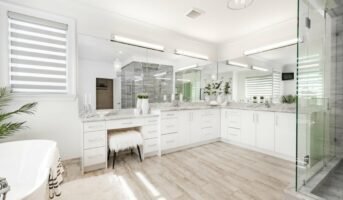In the realm of furniture manufacture and interior design, laminates and veneers are often used as materials. While they both aim to improve surfaces’ aesthetic appeal, their features, applications and compositions are different. Making educated choices about the materials for cabinets, furniture and other interior pieces requires an understanding of the differences between laminates and veneers.
See also: Acrylic laminates Vs PVC laminates
Distinguishing factors for laminates and veneers
Laminates
Made of composite materials, laminates are created by pressing layers of fabric or paper together with resin. The uppermost layer consists of beautiful paper that has been printed to resemble stone, wood, or other textures. A durable, clear overlay that resists fading, stains and scratches shields this layer from harm. For strength and durability, phenolic resin is typically infused into kraft paper to create the base layers.
Laminate finishes
The protective overlay and the printed decorative layer work together to create laminate finishes. A vast array of patterns, textures and colours can be replicated by the ornamental layer. Common varieties include high-pressure laminates (HPL) and low-pressure laminates (LPL), with HPL providing better durability and resistance to outside influences.
Veneers
Veneers are thin, natural wood slices that are usually between 1/32 and 1/16 of an inch thick. Logs are peeled or sliced to produce these slices. Veneers protect the wood species’ original grain patterns and qualities. Usually, plywood or particle board is put on a substrate to form the solid wood appearance.
Veneer finishes
These techniques bring out the inherent beauty of wood. Veneer finishes vary from transparent varnishes that highlight the original colour of the wood to stains that change the colour while preserving the grain’s visibility. Various finishes, such as glossy or matte, influence how the finished product looks.
Advantages and disadvantages
Advantages of laminates
Durability
Laminates are extremely resilient to dampness, stains and scratches.
Variety
When it comes to patterns, textures and colours, laminates provide a wide array of design alternatives.
Affordability
When compared to natural wood veneers, laminates are typically less expensive.
Disadvantages of laminates
Appearance
Some people may still prefer the genuine appearance of real wood, even if high-quality laminates can effectively imitate natural materials.
Repair
If a laminate is broken, it is difficult to fix. Chips or scratches might be irreversible.
Advantages of veneers
Natural Aesthetics
Veneers highlight the distinctive grain patterns of real wood while giving it a realistic and cosy appearance.
Personalization
With veneers, one can choose the type of wood, the treatment and the pattern.
Repairability
If veneers sustain surface damage, they can be sanded down and refinished.
Disadvantages of veneers
Cost
Compared to laminates, real wood veneers may be more costly.
Vulnerability
Due to their thin wood layers, veneers are more susceptible to dents, scratches and impact damage.
The decision between laminate and veneer is influenced by a number of variables, including the material’s intended usage, budget and design preferences. Because of their longevity, laminates are a great option for high-traffic areas or locations that are prone to moisture. Conversely, veneers are the material of choice for people who value wood’s inherent beauty and want a more upscale, genuine look.
Maintenance tips
Maintenance tips for laminates
Frequent cleaning
To keep laminates free of dust and grime, wipe them down with a gentle, moist cloth.
Use gentle, non-abrasive cleansers instead of harsh ones, as they may cause harm to the protective overlay.
Protection from heat
As high temperatures can harm laminates, use trivets or mats to shield them from the sun.
Maintenance tips for veneers
Gentle cleaning
Gently wipe away dust and grime from veneers using a slightly moist cloth.
Avoid excess moisture
Excessive moisture exposure might cause the veneer to warp or break.
Steer clear of direct sunlight
To avoid colour fading and wood damage, keep your exposure to direct sunlight to a minimum.
The decision between laminates and veneers ultimately comes down to individual tastes, financial limitations and the particular needs of the project. It is vital to comprehend the pros and cons of each material in order to make an informed selection. Each material adds a distinct charm to interior spaces, whether you choose the timeless beauty of wood veneers or the durability and variety of laminates.
FAQs
Are laminates a good choice for kitchen countertops?
Yes, laminates are a popular choice for kitchen countertops due to their durability, resistance to stains and a wide range of design options.
Can veneers be used in high-moisture areas like bathrooms?
While veneers can be used in bathrooms, it's essential to take precautions against excessive moisture, such as proper ventilation and sealing the wood.
Do laminates fade over time?
High-quality laminates with UV-resistant overlays are less prone to fading. However, prolonged exposure to direct sunlight may still cause some degree of fading.
Can veneers be refinished if they get scratched or damaged?
Yes, real wood veneers can be sanded and refinished to address surface scratches or damage, restoring their appearance.
Which is more environmentally friendly, laminates or veneers?
Both laminates and veneers have environmental considerations. However, veneers made from sustainably sourced wood may be considered eco-friendlier.
Are laminates suitable for outdoor applications?
Laminates are not recommended for outdoor use as they are not designed to withstand constant exposure to the elements.
What is the lifespan of veneers compared to laminates?
Properly maintained veneers can have a longer lifespan than laminates, as they can be refinished to address wear and tear over time.
Do laminates require special cleaning products?
Laminates are generally easy to clean with mild soap and water. To prevent surface damage, it's advisable to refrain from using abrasive cleaners.
Can veneers be used on furniture with intricate designs?
Veneers are versatile and can be applied to furniture with intricate designs, providing a seamless and decorative finish.
Are laminates scratch-resistant?
While laminates are resistant to scratches, they are not entirely scratch-proof. It's advisable to use cutting boards and avoid dragging sharp objects across the surface.
| Got any questions or point of view on our article? We would love to hear from you. Write to our Editor-in-Chief Jhumur Ghosh at jhumur.ghosh1@housing.com |

Upasana Mandhata, currently in her final year of Law, is pursuing a BA LLB Degree at VIT University Chennai. Her interest in content creation dates back to her school and college years when she discovered a writing passion. Drawing from personal experiences, her writing style has been shaped by her journey and encounters. She enjoys experimenting with new recipes, painting, or swimming while clocking out of work time.











